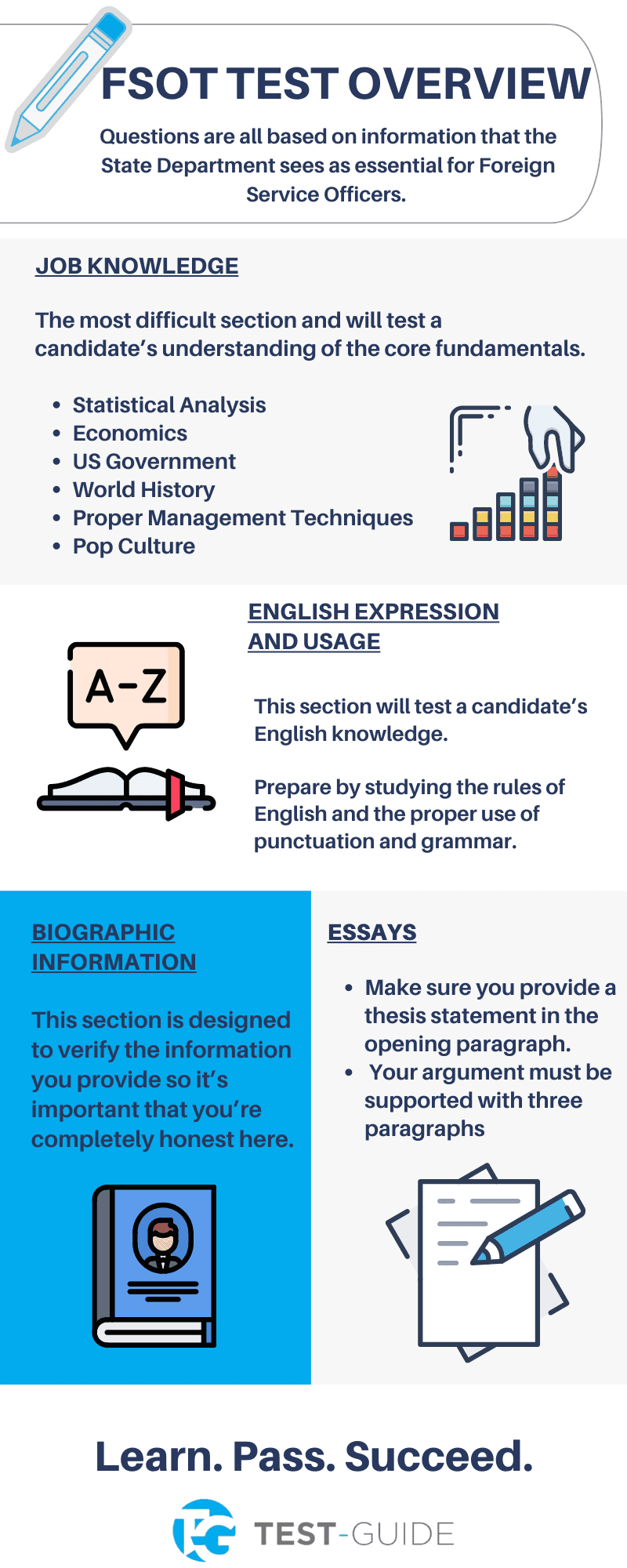The Foreign Service Officer Test (FSOT) is the first step to becoming a Foreign Service Officer. It is a three hour exam that is given at a Pearson testing site. To prepare for this grueling exam, use one of the free FSOT practice tests listed below.
The FSOT is designed to ensure that Foreign Service Workers who enter the field possess the knowledge, skillset, and abilities to perform the job.
Summary: Prepare for the FSOT by utilizing a FSOT practice test.
Free FSOT Practice Tests and Resources
| Resource | Notes | Provider |
| FSOT Practice Test | Take a timed FSOT practice test to prepare. | U.S. Department of State |
| FSOT Practice Test 2 | Review numerous FSOT practice questions. Questions start on page 24 of PDF. | U.S. Department of State |
| FSOT Flashcards Set 1 | Review 190+ terms to help prepare for the FSOT. | Quizlet |
| FSOT Flashcards Set 2 | Review 140+ terms to become more comfortable with the content on the FSOT. | Quizlet |
FSOT Test Overview
The FSOT is administered digitally and has a total of four sections that are broken up throughout the testing period. Questions are all based on information that the State Department sees as essential for Foreign Service Officers. The first three sections are multiple-choice questions while the final section is an essay.
Section 1 – Job Knowledge
This is considered the most difficult section of the FSOT and will test a candidate’s understanding of the core fundamentals. The job knowledge section will tackle the following subjects:
- Math
- Statistical Analysis
- Economics
- US Government
- World History
- Geography
- Technology
- Proper Management Techniques
- Pop Culture
These subjects are not just picked up and learned in a day or two. They are designed to test cumulative knowledge and express the candidate’s experience. Candidates are expected to have a higher than average education.
You should expect random questions related to your educational experience. Taking a FSOT practice test will help applicants understand what they know and do not know.
Section 2 – English Expression and Usage
This section of the FSOT will test a candidate’s English knowledge. The difficulty is on par with the ACT and SAT. Candidates will receive a passage and then get questions related to proper grammar.
You must be have enough knowledge in grammar to understand its proper usage in a somewhat large context. Random rules are going to be asked and their solutions are not going to be obvious.
Prepare by studying the rules of English and the proper use of punctuation and grammar. Flash cards and an FSOT practice test will help you get ready for this grueling section.
Section 3 – Biographic Information
This section will be a section that’s about you, but don’t underestimate it. The information you provide here will be used in the oral assessment that you will take later, assuming you make it that far into the process.
You must be able to back up everything you say here.
This section is designed to verify the information you provide so it’s important that you’re completely honest here. You’ll likely be asked the same questions later on whether it’s on the test or during the oral examination.
As long as you’re honest, then you’ll be fine.
Section 4 – Essays
This section will ask you to answer two questions and it’s important to keep in mind that the answer itself is not being tested, but rather the way you deliver that answer.
There are five essentials that you must accomplish with your answers:
- Make sure you provide a thesis statement in the opening paragraph.
- Your argument must be supported with three paragraphs.
- Provide a counter-argument, and then a counter to that counter-argument.
- End with a conclusion that summarizes all of the points you made.
- Proofread the essay to correct all grammar and spelling errors.
Think of it like a college paper where you need a thesis statement that lists three points you plan to argue. Then argue each of those points, giving one paragraph each. Finally, end with a summary of all three of those points.
Steps to Become a Foreign Service Officer
In order to become a Foreign Service Officer, a candidate must complete several steps. You can learn more about those steps below.
Step 1 – Choose a Career Track
Candidates will be asked to select a career track when registering for their FSOT exam. All U.S. diplomats are expected to communicate effectively with host governments, but each career track has a specific focus. Applicants may not change career tracks after they are selected. Some career tracks are:
- Consular
- Economic
- Management
- Political
- Public Diplomacy
Each career track offers something different. The U.S. State Department reviews each career track in-depth.
Step 2 – Register for the FSOT
The FSOT is administered in one 3-hour window and is generally offered in February, June, and October. It’s generally given at the Pearson testing site but candidates overseas can find testing slots at specific U.S. Embassies.
Beginning in January 2020, candidates will need to submit six personal narratives when registering for the FSOT.
Step 3 – Take the FSOT
There are a number of requirements that candidates must go through before they can even be considered for the FSOT. Some of the requirements include:
- Candidate must be a U.S. citizen on the date they register for the FSOT.
- Candidate must be at least 20 years old and no older than 59 years old when they register for the FSOT.
- Candidate must be at least 21 years old and not yet 60 years old when they are appointed as a Foreign Service Officer.
- Candidate must be available for worldwide assignments
Step 4 – Evaluation Panel
After taking and passing the FSOT multiple choice section, your written essays will be reviewed by a panel – your personal narratives will also be reviewed.
Step 5 – Oral Assessment
The oral assessment is given to candidates who have met and passed all the steps leading up to this point. The oral assessment is a day-long assessment that is conducted in-person.
Applicant will be tested on their ability to demonstrate the 13 dimensions that are essential to a successful Foreign Service Officer. Included in this assessment are group exercises, structured interviews, and a case management writing exercise.
Step 6 – Medical and Security Clearances
This is the real deal breaker for a lot of people. In order for your application to be accepted, you must pass a medical and security check.
Since the application process is so time-consuming, it’s best to make sure you meet the requirements before applying. Otherwise, you’re just wasting your time.
- You cannot have any illegal activities on your record. Criminal activities like DUI or drug charges will get rejected immediately.
- You must be willing and able to provide a comprehensive list of every address you have lived at for the past 10 years. Furthermore, you must provide the name and contact information of someone unrelated to you so that they can verify that you’ve lived at that location.
- You cannot be married to an individual who is a foreign national who has a background that might be a concern for U.S. national interests. This includes, but is not limited to, individuals who have a nationality to a rival country (i.e. China or Iran).
Step 7 – Suitability Review Panel
After completing all of the above steps, a panel will review you whole application and candidate profile. Everything you have completed up to this point will be reviewed except your medical records.
Step 8 – Placed on the Register
If you successfully pass all of the steps, you will be placed on the register. The register is a list of successful candidates that is sorted by career tracks.
FSOT Scoring
154 is the magic number that you’re looking for on the multiple choice sections of the FSOT. For the essay section, 6 or above is considered passing. However, passing this section is just one step in a lengthy approval process.
The overall body of work is then handed to a Qualifications Evaluation Panel (step 4) where they review the candidates to determine who to invite to Washington DC. Invitations are for an oral assessment (step 5).
What this all means is that while a higher score on the FSOT does improve your chances of passing the QEP, it’s not the only factor that’s considered.
The personal narrative essays are actually given far more weight than the FSOT, but that doesn’t mean that you should take the exam lightly. Prepare, study, and take an FSOT practice test so that you give yourself the best chance of success.
Test Day Expectations
You will have to bring a valid government-issued ID when you arrive to take the exam. When taking the test abroad, you’ll need your passport.
Make sure you are at the testing facility at least 30 minutes before your test. If there are delays and for some reason you are not in the doors on time, then you’ll not be allowed to take the test. There are no exceptions.
FSOT FAQs
What material should I use to study for the FSOT?
This is tricky since the test will change every time it’s taken. However, there is one sure fire way to offset this and give yourself a slight edge.
The first step is to take a practice FSOT test. In fact, take several of them! I cannot emphasize this enough because it will get you into a test-taking mindset.
Taking a practice test will show you the weakest areas. Focus on those weaknesses and read up on those areas thoroughly. Practice testing won’t show you whether or not you can pass this exam, but it will help guide your study direction.
It also won’t hurt to find a couple of FSOT prep books and read through them. There are a ton of resources and this exam is so complex that it’s a good idea to find sources from a variety of sources.
Finally, give yourself six months to prepare for this exam.
What are the chances of becoming a FSO right after graduation?
If you haven’t already started the hiring path before graduation, then your chances of getting hired are slim. Every step of the process takes time. It’s a tedious process.
It easily takes over a year to get added to the registration. With that said, you can apply for the test and take it to get that part out of the way. But you should continue your life as normal since the odds are stacked against you.
How long does it take to find out if I passed?
You will know your score within three weeks of taking the test. However, the required score changes on an annual basis. But to answer the question, three weeks is the safest bet.
If you fail, you’ll have to wait a full year to retake it.


